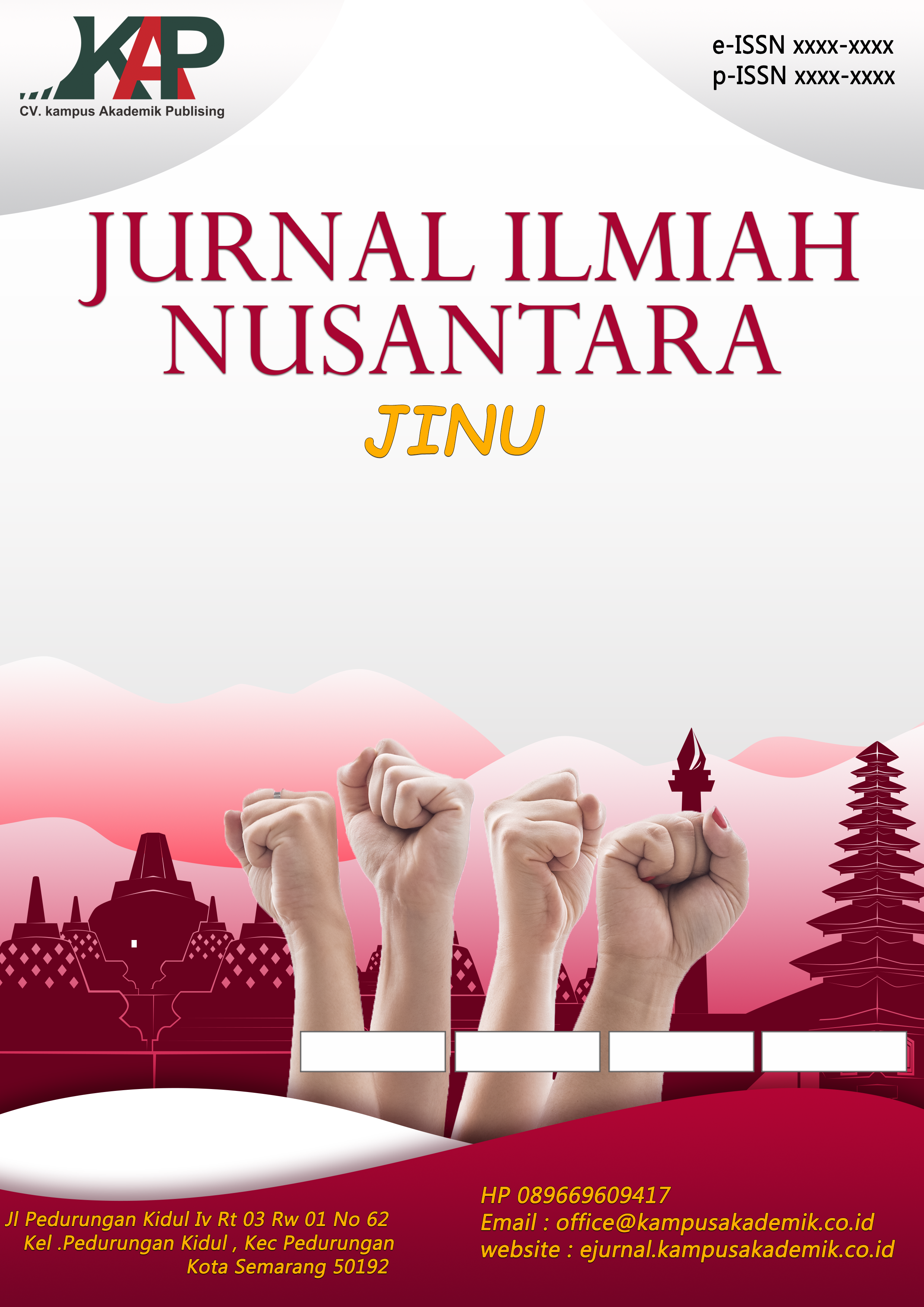RANCANG BANGUN PEMBUATAN STOP KONTAK CERDAS BERBASIS INTERNET OF THINGS (IoT) UNTUK EFISIENSI PENGGUNAAN LISTRIK
DOI:
https://doi.org/10.61722/jinu.v2i5.5590Keywords:
Active Learning, Quiz Team, Learning Interest, Fiqh.Abstract
Technological advancements have significantly contributed to improving efficiency in various human activities, including electricity usage. One promising solution is the development of a smart socket system based on the Internet of Things (IoT), which enables users to remotely control and monitor electrical devices via the Blynk application on Android smartphones. This system employs components such as relays and WiFi connectivity to provide real-time information about the operational status of the socket. This study aims to design a smart socket system using IoT, understand its operating principles, and evaluate its performance. The research methodology includes several stages: component requirement analysis, mechanical design, hardware assembly, programming, and device testing. The Blynk application serves as the remote control interface, while IoT methodology allows the integration of the device with internet networks. The results indicate that the system performs effectively: the smart socket can be controlled remotely with high efficiency, and users can monitor its status in real-time from any location. Although the system lacks visual indicators such as on/off lights, it still offers substantial benefits in enhancing electricity usage efficiency. The potential benefits of this research include assisting users in managing electrical energy more efficiently, providing a practical reference for students interested in Arduino and IoT technologies, and contributing to academic institutions in teaching and further research on related topics. In conclusion, the IoT-based smart socket system integrated with the Blynk application presents a practical and accurate solution for managing electrical energy in households or small-scale industries.
References
Alsulami, M. M., & Akkari, N. (2018). The role of 5G wireless networks in the internet-ofthings (IoT). 2018 1st International Conference on Computer Applications & Information Security (ICCAIS). Riyadh.
Andalan. (2018, Agustus 07). Mengenal Arduino : Pengertian, Sejarah, Kelebihan dan JenisJenisnya. Diambil kembali dari andalanelektro.id.
Arifin, B. (2013). Aplikasi Sensor Passive Infrared (PIR) Untuk Pendeteksian Makhluk Hidup Dalam Ruang HIDUP DALAM RUANG. Prosiding SNST, Vol 1, No 1 (2013).
Aripiyanto, S., & Tukino. (2018). Penghematan Energi Listrik Dengan Stop Kontak Otomatis Berbasis Mikrokontroler PIC I6F84/A dan Sensor PIR Studi Kasus Pada PT. Mushasi Auto Part Indonesia. Buana Ilmu, Vol 2(Vol 2 No 2 (2018): Buana Ilmu), No 2.
Basri, I. Y., & Irfan, D. D. (2018). Komponen Elektronika. Padang: Sukabina. Charun, R. (2017). Pengendali Stop Kontak Menggunakan Android. Jurnal Politeknik Negeri Batam.
Coulombe, B. (2021). Tech Trends: The Next Evolution of Motion Detection. LiDAR is changing the way integrators approach the well-established technology.
Destiariani, & Kumara, P. W. (2019). Robot Line Follower Berbasis Mikrokontroller. Jurnal Informanika, Volume 5 No.1. doi:https://doi.org/10.52233/informanika.v5i1.74
Lee, Y., Jiang, J., Sanders, A., Osborne, M., & Underwood, G. (2017). Smart Power-Strip: Home Automation by Bringing Outlets into the IoT. 2017 IEEE 8th Annual Ubiquitous Computing, Electronics and Mobile Communication Conference (UEMCON).
Madoi, Y. P. (2018). Rancang Bangun Alat Pengaman Rumah menggunakan Sensor Pir Berbasis Sms Gateway.
Mambang. (2021). Buku Ajar Teknologi Komunikasi Internet (Internet of Things) (Cetakan pertama ed.). Banyumas: CV. Pena Persada.
Martha, E., & Kresno, S. (2016). Metodologi Penelitian Kualitatif. Jakarta: Rajawali Press.
Nur Iksan, F., & Tjahjadi, G. (2018). Perancangan Stop Kontak Pengendali Energi Listrik Dengan Sistem Keamanan Hubung Singkat dan Fitur Notifikasi Berbasis Internet Of Things. Jurnal Elektro, Vol 11(Vol 11 No 2 (2018): Oktober 2018), No 2.
Nursamsi Adiwiranto, M., & Budi Waluyo, C. (2021). Prototipe Sistem Monitoring Konsumsi Energi Listrik Serta Estimasi Biaya Pada Peralatan Rumah Tangga Berbasis Internet of Things. ELECTRON : Jurnal Ilmiah Teknik Elektro, 2(2), 13–22. https://doi.org/10.33019/electron.v2i2.2
Napis, Farhan, M., Rahmatulloh, Hakim, A. R., & Apriyanto, M. T. (2023). Meningkatkan Kesadaran Masyarakat Dalam Budaya Hemat Energi Melalui Penyuluhan Efisiensi Penggunaan Listrik Rumah Tangga. Jurnal Pendidikan Dan Pengabdian Masyarakat, 6(2), 1–23. https://doi.org/http://dx.doi.org/10.29303/jppm.v6i2.4980
Prastiantari, A., Hermin, F., & Mulyono. (2017). SKOPIN (Stop Kontak Pintar) Pengendali Arus Listrik Menggunakan Timer Pada Stop Kontak Berbasis Arduino. Jurnal Ilmu Komputer dan Aplikasi, 1(Vol 1 No 1 (2017): Jurnal Ilmu Komputer dan Aplikasi), 1.
Rahayu, E. S., & Nurdin, R. A. (2019). Perancangan Smart Home Untuk Pengendalian Peralatan Elektronik Dan Pemantauan Keamanan Rumah Berbasis Internet Of Things. Jurnal Teknologi, Vol 6, No 2 (2019). doi:https://doi.org/10.31479/jtek.v6i2.23
S. Margono. (2013). Metodologi Penelitian Pendidikan. Jakarta: Rineka Cipta.
Santoso, A. D., & Salim, M. A. (2019). Penghematan Listrik Rumah Tangga dalam Menunjang Kestabilan Energi Nasional dan Kelestarian Lingkungan. Jurnal Teknologi Lingkungan, Vol 20, No 2. doi:https://doi.org/10.29122/jtl.v20i2.3242
Saputro, T. T. (2019, Desember 24). Mengenal Relay Dan Cara Kerjanya. Diambil kembali dari embeddednesia: https://embeddednesia.com/v1/mengenal-relay-dan-carakerjanya-bagian-1/
Seneviratne, P. (2018). Hands On Internet of Things with Blynk. Mumbai: Packt.
Subahani, A. (2018). Rancang Bangun Sistem Keamanan Gudang Sparepart Mobil Menggunakan Sensor PIR dan RFID Berbasis Mikrokontroller Atmega 328.
Suraidi, S., & Nathania, S. (2019). Sistem Pengendali Smart-Kontak dengan Aplikasi Android dan Web. Tesla, Vol 21, No 2 (2019). doi:10.24912/tesla.v21i2.7183
Yudhanto, Y., & Azis, A. (2019). Pengantar Teknologi Internet of Things (IoT) (Edisi 1 ed.). Surakarta: UNS Press.
Downloads
Published
Issue
Section
License
Copyright (c) 2025 JURNAL ILMIAH NUSANTARA

This work is licensed under a Creative Commons Attribution-ShareAlike 4.0 International License.













